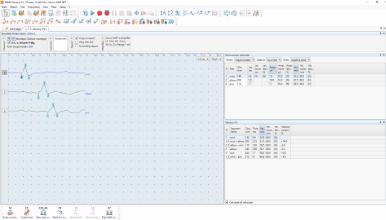PELVIC FLOOR
- specific techniques for neurophysiological assessment of external sphincter and other pelvic floor neuromuscular structures
- portable design
- electrical stimulator with two outputs

Description
In coloproctology centers, EMG of external sphincter and pelvic floor muscles is often required.
Portable EMG and NCS system Neuro-MEP-Micro packed with the necessary techniques is the right solution for these needs.
Specific techniques for neurophysiological assessment of external sphincter and other pelvic floor neuromuscular structures
The system is used to perform various neurophysiological examinations of pelvic floor for diagnostic and scientific purposes, i.e.:
- bulbocavernosus and other sacral reflex tests with electrical stimulation of pudendal nerve to assess the conduction of reflex arcs (S2-S4);
- surface EMG of external sphincter and pelvic floor muscles to assess the level of tonic contraction;
- needle EMG with quantitative motor unit potential (MUP) analysis coupled with sacral reflex test to detect sacral denervation;
- stimulation EMG used with a disposable St. Mark’s electrode to stimulate the distal part of pudendal nerve;
- pudendal nerve somatosensory evoked potentials (pSEPs) especially in patients with preserved sacral reflexes and hypoesthesia of perineum;
- sympathetic skin responses (SSR) recorded from perineal area to assess the conduction velocity of sympathetic unmyelinated fibers and myelinated sensory nerve fibers;
- analysis of motor evoked potentials (MEP) in perineal muscles during the cortical and sacral magnetic stimulation (the assessment of corticospinal tract conduction with recording of pelvic floor motor evoked potentials (if the magnetic stimulator is available)).
Portable design
Neuro-MEP-Micro requires very little space and is connected to a computer via the USB cable which ensures data uploading and power supply of the device. If not powered from mains, the device can operate from the notebook battery.
Electrical stimulator with two outputs
Two software switchable outputs to plug in the electrical stimulator allow a specialist to place two pairs of stimulating electrodes on a patient and connect them to the device. Thus, there is no need to switch the electrodes as the stimulating electrode is software-defined.
The list of articles on research using Neuro-MEP-Micro at Google Scholar.
Delivery Set
The delivery set can differ from country to country. Request the actual delivery set for your country from your local representative.
| T-3/A trolley | 1 pcs. |
| Neuro-MEP-Micro (2009) | 1 pcs. |
| Neuro-MEP-Micro electronic unit | 1 pcs. |
| Neuro-MEP.NET software license with Neuro-MEP.NET/EMG module | 1 pcs. |
| USB cable (A-B) (1,8 m) | 1 pcs. |
| Neuro-MEP.NET software license with Neuro-MEP.NET/HW module | 1 pcs. |
| SH-1S small holder | 1 pcs. |
| Mounting bracket | 1 pcs. |
| Stimulating bar electrode (adult) SBE-2 | 1 pcs. |
| Cup EP electrode with cable EEP (5 pcs.) | 1 pcs. |
| Ring electrode with cable (wide) RE-2 | 1 pcs. |
| Ground electrode with cable (pediatric, 250 mm) GE-1 | 1 pcs. |
| Ground electrode with cable (adult, 400 mm) GE-2 | 1 pcs. |
| Bar electrode (adult) BE-2 | 1 pcs. |
| Bar electrode (pediatric) BE-1 | 1 pcs. |
| Surface electrode with cable SE-1 | 2 pcs. |
| Adapter for needle electrode connection D60451 | 1 pcs. |
| Disposable concentric EMG needle electrode B50600 (l=37 mm, d=0,45 mm) | 50 pcs. |
| Disposable ECG electrode F9049 (price for 1 pcs., comes in packs of 100 pcs.) | 100 pcs. |
| Cable for disposable electrode with alligator clip and touch-proof connector (black, 0,2 m) | 1 pcs. |
| Cable for disposable electrode with alligator clip and touch-proof connector (red, 0,2 m) | 1 pcs. |
| Y-adapter | 1 pcs. |
| Measuring reel | 1 pcs. |
| Marker pen | 1 pcs. |
| Ten20 сonductive paste | 1 pcs. |
| Сonductive and abrasive paste, G999 (EVERI) | 1 pcs. |
| Transpore medical tape | 1 pcs. |
| Package set | 1 pcs. |
| Technical Manual «Neuro-MEP-Micro (ver.2009)» | 1 pcs. |
| Workbook "EMG Studies Using Neurosoft Digital EMG and EP Systems" | 1 pcs. |
| User Manual | 1 pcs. |
| Annex to user manual «Exam Manager» | 1 pcs. |
| Warranty certificate | 1 pcs. |





